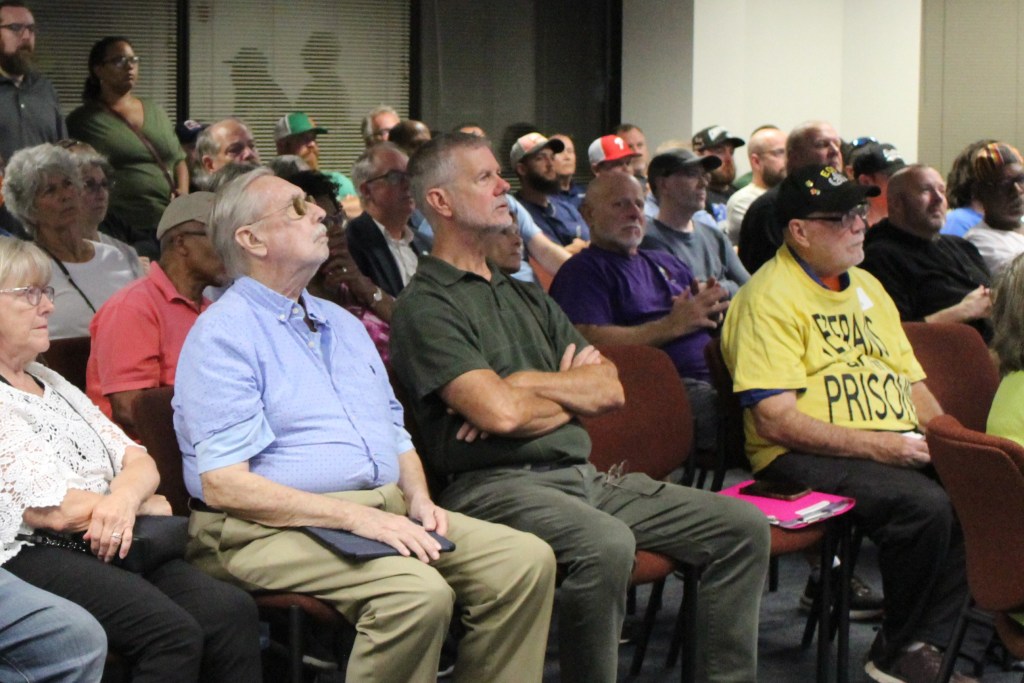Spotlight Delaware is a community-powered, collaborative, nonprofit newsroom covering the First State. Learn more at SpotlightDelaware.com.
After months of relative quiet, the company behind plans to build an energy-hungry data center in Delaware has launched a public relations campaign to convince skeptical residents to join its side.
Starwood Digital Ventures wants to build a 6-million-square-foot data center near Delaware City that would consume the same amount of electricity from the grid as nearly 1 million homes, according to expert estimates.
The massive scale of the facility – which company officials say could be worth $7 billion – would have made it among the largest in the country in past years. But today it is part of a boom of proposed data centers of a similar size, fueled largely by investors chasing the expected riches of the artificial intelligence industry.
While Starwood officials say the facility would bring hundreds of jobs and millions of dollars in new taxes to Delaware, their proposal has sparked a backlash from residents and environmental groups who say the large data center would raise electric bills and harm the local environment.
In response, Starwood officials have bought advertisements on Facebook urging Delawareans to tell their elected officials to support “Project Washington” – their name for the data center plan – because of the jobs and tax revenue it would bring to the state.
“Tired of tax increases? Support Project Washington!” one of the advertisements said, referencing recent property tax spikes that occurred in several school districts across New Castle County.
“If we don’t seize this moment, another state will,” another advertisement said.
The ads come as state and county elected officials have scrambled to pass new laws to more tightly regulate data centers, particularly their energy use.
In July, New Castle County Councilman Dave Carter proposed legislation that would impose a broad swath of restrictions limiting where and how data centers operate. The county planning board will vote on whether to recommend approval of the measure during a meeting on Oct. 21.
During the planning board’s previous meeting last Tuesday, roughly 200 people packed into a county building. During the meeting’s public comment period, most expressed support for Carter’s ordinance.
 Roughly 200 people crowded into a New Castle County Planning Board meeting in October, 2025, mostly to oppose plans for a data center near Delaware City | SPOTLIGHT DELAWARE PHOTO BY OLIVIA MARBLE
Roughly 200 people crowded into a New Castle County Planning Board meeting in October, 2025, mostly to oppose plans for a data center near Delaware City | SPOTLIGHT DELAWARE PHOTO BY OLIVIA MARBLEAre the ads accurate?
In its advertisements, Starwood asserts that its data center would bring 700 jobs to the area — much higher than its initial estimate of 250 jobs.
In an interview with Spotlight Delaware, Starwood CEO Anthony Balestrieri said the initial estimate referenced only the jobs directly related to running a data center, and not ones from companies that would lease it out.
One economic development analyst who separately spoke with Spotlight Delaware said the job estimate is likely accurate, given the data center’s proposed size.
Ellen Miller, a co-author of a report about the effect of data centers on Virginia’s economy and energy infrastructure, said such facilities create roughly one full-time job for every 9,000 to 10,000 square feet. For the Delaware City proposal, that would amount to about 600 to 667 jobs.
Still, Miller said Starwood’s estimate for its economic impact seems less likely.
Starwood’s ads claim its Delaware data center would create $9.7 billion of economic output during construction of the facility.
Miller said all of the data centers across Virginia – a major hub for the industry – produced about $13.3 billion in economic output during their construction, according to her team’s calculations.
Another Starwood ad claimed its data center would provide $54 million in annual property tax revenue to area schools and $17 million to New Castle County.
Based on the school tax rate, the figure indicates that Starwood estimates the data center and its property to be worth more than $7 billion. Miller said the estimated value is possible because of a spike in asset prices within the industry.
 New Castle County Councilman Dave Carter speaks about data centers at a planning board meeting in October 2025. | SPOTLIGHT DELAWARE PHOTO BY OLIVIA MARBLE
New Castle County Councilman Dave Carter speaks about data centers at a planning board meeting in October 2025. | SPOTLIGHT DELAWARE PHOTO BY OLIVIA MARBLEIn recent years, growth in the U.S. economy has been increasingly fueled by investments in the artificial intelligence industry, which consequently has driven up the values of everything from computer chips to data centers.
However, the recent reassessment controversy in New Castle County has proven that assessors will only consider the building as rentable space, and not its current use, likely limiting the assessed value. Several major commercial properties were assessed far under their market values because of that approach.
Carter, who proposed the county legislation to regulate data centers, said it is impossible to determine the amount of tax revenue the data center project would bring to Delaware because a tax reassessment has upended the way the county values properties. He also noted that Starwood has not yet submitted detailed plans for the data center project.
“Anything they provided, in my view, is nothing but a propaganda number,” Carter said.
 A rendering shows plans for a massive Delaware City data center dubbed Project Washington | PHOTO COURTESY OF STARWOOD DIGITAL VENTURES
A rendering shows plans for a massive Delaware City data center dubbed Project Washington | PHOTO COURTESY OF STARWOOD DIGITAL VENTURESHow much water will it use?
After three months of unanswered media requests for comments, a public relations firm called Commonwealth Consultants recently scheduled an interview with Spotlight Delaware and five Starwood representatives to discuss what they said were the positive impacts of the project.
During the interview, the representatives said the Delaware City data center would use much less water than typical facilities – estimating the amount at about 13 million gallons per year. The facility could achieve the lower figure because it would use a closed-loop cooling system, they said, which is more water-efficient than traditional cooling methods that draw water in one end and expel it out the other.
Developers of data centers must build complex cooling systems that draw from local water supplies in order to prevent overheating of computer servers that run 24/7 within a confined space.
As a result, water usage by data centers has become a flashpoint for environmentalists.
David Tilley, a University of Maryland professor who studies environmental science, said the 13-million-gallon estimate sounds “extremely low” for a facility the size of the Delaware City data center, but could be possible if Starwood uses refrigerant-based heat pumps for cooling.
Effect on electricity prices
By far the biggest point of criticism for the proposed Delaware City data center is its electricity usage, with opponents arguing that its energy demand will push up power bills that have already been surging over the past year.
Starwood’s CEO Balestrieri said his company’s plan is to locate the data center along a high-voltage power line, so it will not need to build much new electricity supply infrastructure.
Balestrieri also said he is considering placing solar panels on the roofs of the data center buildings, though he said it would only produce a small portion of the energy needed for the site.
 Delaware energy regulators voted to stop energy-hungry data centers from connecting to the electric grid until a new electricity rate for them is calculated. | PHOTO COURTESY OF UNSPLASH
Delaware energy regulators voted to stop energy-hungry data centers from connecting to the electric grid until a new electricity rate for them is calculated. | PHOTO COURTESY OF UNSPLASHAbraham Silverman, assistant research scholar at Johns Hopkins University and former executive at NRG Energy, said there is just no way to know what electricity infrastructure upgrades may be needed before a thorough analysis of the grid in the local area.
Still, Silverman said studies are clear that data centers overall raise electricity rates for consumers in a region.
Delaware is part of the PJM grid, which has already seen increased electricity prices as the development of new power plants continues to fall behind the increased demand for power in the region, in part from data centers.
PJM saw 5,000 megawatts of new data centers coming onto its markets in one year, Silverman said.
“That is the equivalent of a little bit more than half of Philadelphia,” Silverman said.











(0) comments
Welcome to the discussion.
Log In
Keep it Clean. Please avoid obscene, vulgar, lewd, racist or sexually-oriented language.
PLEASE TURN OFF YOUR CAPS LOCK.
Don't Threaten. Threats of harming another person will not be tolerated.
Be Truthful. Don't knowingly lie about anyone or anything.
Be Nice. No racism, sexism or any sort of -ism that is degrading to another person.
Be Proactive. Use the 'Report' link on each comment to let us know of abusive posts.
Share with Us. We'd love to hear eyewitness accounts, the history behind an article.